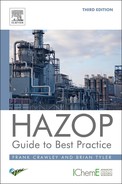Foreword
Foreword To Third Edition
It is with great pleasure that I have been invited to offer a preface to this, the third edition of HAZOP Guide to Best Practice which is certainly one of the most popular IChemE texts that has been developed by EPSC members since the inception of the Centre in 1992.
This particular book has fond personal memories because several years ago when working in industry I attended an IChemE HAZOP for Team Leaders course with one of its authors, Brian Tyler, which was held at the former UMIST campus in Manchester. The opportunity presented during that course of managing a HAZOP study team gave me the necessary confidence back at the workplace to train frontline staff in the use of the technique, then lead a team in a study on a fully functioning gin distillery, and finally present the recommendations to the site executive team. I still have the course folder, and I am glad to see that much of that content still forms the core of this current text.
Nevertheless much has happened since the first edition and nothing stands still for long and so for the technique of HAZOP. There is now much greater appreciation in HAZOP studies of human error in accident causation and more broadly human factors and the role of automation. HAZOP studies are now performed routinely on continuous plants at various stages of operation such as start-up and shutdown, batch processing plants, and even packaging plants. The technique of deviation analysis inherent in the method lends itself with care and imagination to many diverse major hazard environments.
As for this third edition, the authors, Brian Tyler and Frank Crawley, are to be praised for their collective efforts in revising this book yet again and keeping the content as fresh and topical as possible. HAZOP provides both a structure for the team identification of hazards, accident scenarios, and operability issues while offering the chance for an element of creative thinking for a team whose time and effort is well managed. If anything the pressure in recent years has grown on the typical HAZOP team to identify and address all conceivable hazards arising from dangerous operations which makes this new edition particularly welcome for students and practitioners alike.
I have no doubt that EPSC members who contributed to the first edition will be immensely proud to see that this book has become a standard reference among the process safety community.
December 2014
Foreword to Earlier Editions
Hazard and Operability Studies (later shortened to HAZOP) were devised by ICI in the late 1960s, following some major problems with new, large process plants. The study was an evolution of method study and was used during the design stage of a project to identify and correct design faults which might lead to Hazard or Operability problems. Over the last few decades, the need for high standards in safety and the environment is fully recognized by the Regulator, the industry, and the public.
HAZOP is now the first choice tool for the identification of weaknesses in the process design and is used worldwide within the process industry. It has been used in a modified form outside the process industry.
The first definitive guide on Hazard and Operability Studies was issued by the Chemical Industries Association in 1974 when the tool had been fully developed. This remained the main guidance for 26 years. However, in that period, new ideas on HAZOPs had been developed and equally some poor practices had been adopted. In 1998, it was decided that a new guide, using best practice, should be written. The first edition of this guide was published in 2000. For the second edition, the authors took the opportunity of reviewing that guide and incorporating better practices and giving more guidance on how these might be applied. In particular the new guide addresses Computer-Controlled Processes.
Although the basic approach of HAZOP is unchanged, there is now considerable experience in how the technique can be used most effectively. This experience has been drawn upon in preparing this guide, with a total of 31 companies contributing to its preparation.
Finally, the guide is important as a joint project which has the support of the Institution of Chemical Engineers (IChemE), the Chemical Industries Association (CIA), and the European Process Safety Centre (EPSC).
Our thanks are due both to the authors of the guide and to the many industrial members who assisted in its development.
